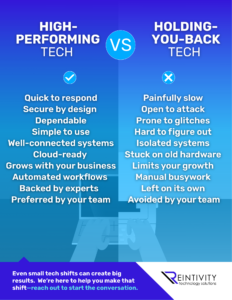
Click the image to view the guide.

Click the image to view the guide.
Technology keeps every school day moving: buses scheduled, meals served, teachers informed, families connected, and compliance in check. We rarely think about that… until suddenly the screen won’t load, the system won’t respond, and everyone is asking what’s going on.
Let’s be honest: school systems are resilient, and educators are unbelievably resourceful. But if technology went down for more than a few hours?
That’s when the real operational stress begins.
So here’s the practical question this eGuide helps you explore:
If your district’s technology went offline today — how long could you keep running smoothly?
This isn’t a scare tactic — it’s preparation. Because planning ahead is how districts stay steady in moments that could otherwise derail vital services. And those moments happen more often than many realize.
A Week Without Technology: The Disruption Grows Each Day
Let’s walk through a scenario based on real incidents involving K–12 environments. As you read each day, ask yourself:
How would our district handle this?
Day 1 — Email Goes Down
No updates from principals. No direction to teachers. No communication to families.
Everyone is improvising — and communication breakdowns multiply quickly.
Day 2 — Files and Curriculum Disappear
Lesson plans. Shared documents. Online assignments.
Staff scramble to recreate what was digital just yesterday.
Day 3 — Mission-Critical Data Becomes Inaccessible
Student information systems, IEPs, emergency contacts — unavailable.
Suddenly, basic student support becomes far more difficult.
Day 4 — Accountability Deadlines Collapse
Attendance, grading, state reporting — halted.
Parents start calling. Board members start asking urgent questions.
Day 5 — Services and Safety Are Compromised
Transportation plans, cafeteria systems, even building access systems rely on tech.
If one breaks… others may follow.
Day 6 — Public Trust Is Tested
Families go to the news. Social media demands updates.
Leadership must explain what’s happening — without knowing when it ends.
Day 7 — The Big Question Arrives
If technology isn’t operational again tomorrow…
Do we close schools?
By now, disruption has become crisis.
And while this is a fictional timeline — the stakes are very real.
Organizations often don’t realize how mission-critical technology is… until it’s gone.
Downtime Isn’t Just “Technical Difficulty”
It affects every operational responsibility a district holds:
- Payroll delays
- Transportation interruptions
- Inability to document services
- Loss of staff productivity
- Parent confidence shaken
Downtime disrupts operations and delays work — those delays have consequences.
The longer outages last, the more recovery turns into urgent, expensive damage control.
School doesn’t get a pause button. Operations must continue.
Why Technology Breaks Down in K–12
It’s rarely one thing. And it’s rarely something districts can completely prevent.
Common drivers include:
- Ransomware and phishing targeting school staff
- Hardware and software failures
- Human error — still the most common cause of downtime
- Minimizing-Downtime_Protect-You…
- Storm damage or accidents
- Systems patched… but never tested
- Legacy solutions stitched together year after year
Even high-performing districts are vulnerable. Budget cycles and daily demands don’t leave room for every upgrade.
The goal isn’t perfection.
It’s resilience.
What Helps Schools Stay Operational Through Outages
There’s one factor that determines how fast stability returns:
How quickly can you recover?
A good backup strategy:
- Saves the right data regularly
- Restores it quickly and simply
- Is tested, not assumed
But recovery depends on people too:
- Who leads the response?
- How do staff teach or operate while systems are down?
- What communication channels still work?
Planning and practice are what turn chaos into coordination.
Five Questions Every District Leader Should Know the Answer To
Take a moment and answer honestly:
- If technology failed today, how do we communicate?
- What systems must be recovered first to avoid service disruption?
- Has our SIS recovery process been tested in the last year?
- Could we meet compliance deadlines during an outage?
- How fast could we restart operations in a crisis?
If any answer creates hesitation…
it’s a perfect starting point for improvement — not a mark against you.
Partnerships Make Resilience Possible
Your IT team carries a huge responsibility. They keep your district functional every day — and that’s already a full load.
When the unexpected occurs, having a skilled partner amplifying their efforts can make all the difference.
A continuity-focused partner can help:
- Validate recovery speeds
- Strengthen operational workflows
- Build confidence with leadership and the community
- Reduce downtime from days to hours
In Chicagoland, Reintivity supports local school districts with that continuity and readiness expertise — strengthening operations while preserving the focus on student services and compliance.
Your staff leads the mission.
Your partner ensures the mission never stalls.
A More Resilient Tomorrow Starts With One Step
No district improves continuity by accident.
It happens through:
- Awareness
- Collaboration
- Confidence in the plan
You don’t need to solve everything at once. Just start with clarity.
A short readiness assessment can reveal what’s working well today —
and where a little preparation could prevent a major disruption later.
Because school shouldn’t stop when the systems do.


